RBSE Solutions for Class 6 Science Chapter 7 Cell are part of RBSE Solutions for Class 6 Science. Here we have given Rajasthan Board RBSE Class 6 Science Chapter 7 Cell.
| Board | RBSE |
| Textbook | SIERT, Rajasthan |
| Class | Class 6 |
| Subject | Science |
| Chapter | Chapter 7 |
| Chapter Name | Cell |
| Number of Questions Solved | 46 |
| Category | RBSE Solutions |
Rajasthan Board RBSE Class 6 Science Chapter 7 Cell
Intext Questions
Question 1.
Can you guess the total number of cells in our body? (Page 54)
Answer:
Yes, there are billions of cells in our body.
Question 2.
Various types of cells are found in our body. What is their shape? (Page 55)
Answer:
Some cells are round and flat. Some are long and spindle shaped and some are quite long and branched.
Question 3.
Do bigger organisms have larger cells? (Page 56)
Answer:
It is not necessary that the size of cells in large organisms will be large and the cells in small organisms will be smaller.
Question 4.
Mark (✓) on the correct option in the table given below. (Page 59)
| Part of Cell | Animal Cell | Plant Cell |
| 1. Cell membrane | Present/ Absent | Present/ Absent |
| 2. Position of nucleus | In Centre/on and side | In Centre/ on one side |
| 3. Size of vacuole | Small/big | Small/big |
| 4. Plastid | Present/ Absent | Present/ Absent |
Answer:
Animal Cell:
1. Absent (✓)
2. in center (✓)
3. small (✓)
4. absent (✓)
Plant Cell :
1. Present (✓)
2. on one side (✓)
3. big (✓)
4. Present (✓)
Exercises
Choose the correct option
Question 1.
Who discovered cell?
(a) Robert Brown
(b) Robert Hooke
(c) Schleiden
(d) Schwann
Answer:
(b) Robert Hooke
Question 2.
Which of these is absent in the animal cell?
(a) Mitochondria
(b) nucleus
(c) Cytoplasm
(d) plastid
Answer:
(d) plastid
Question 3.
A group of similar cells performing a specific function is called
(a) Organ
(b) Cell
(c) System
(d) Tissue
Answer:
(d) Tissue
Fill in the blanks
1. Thread like structures found in the nucleus are called …………
2. Amoeba is a ……….. organism.
3. An organism made up of more than one cell is called ………….. organism.
4. Nerve cells are …………… and ………….. .
Answer:
1. chromosomes
2. unicellular
3. multi – cellular
4. long, branched
Short Answer Type Questions
Question 1.
What is the difference between prokaryotic and eukaryotic cell?
Answer:
Difference between prokaryotic and Eukaryotic cell :
| Prokaryotic Cell | Eukaryotic cell |
| 1. Nucleus is not enveloped by a nuclear membrane. | 1. Nucleus is enveloped by a nuclear membrane. |
| 2. Cell organelles like mitochondria, plastid, golgi apparatus etc. are not present. | 2. In these cell organelles are present. |
Question 2.
Define a tissue.
Answer:
A group of cells performing similar function is called a tissue.
Question 3.
Why mitochondria is called the power house of the cell?
Answer:
Biological energy ATP is produced in the mitochondria. That is why, it is called the power house of the cell.
Question 4.
Why lysosome is known as suicidal bag?
Answer:
When the cell gets injured or is dead, then the lysosomes rupture and the digestive enzymes digest their own cell. That is why, they are called suicidal bags.
Long Answer Type Questions
Question 1.
Explain the following parts of the cell along with diagrams
1. Nucleus
2. Cell membrane
3. Cytoplasm
Answer:
1. Nucleus – It is generally spherical in shape. In animal cells, it is located in the centre but in plant cell, it is towards one side due to large vacuoles. It is enveloped by a double layered membrane. This membrane is porous and allows the movement of materials. Nucleus contains a small dense structure called the nucleolus. Nucleus contains thread like structures called chromosomes. Chromosomes carry genes which carry hereditary information from the parents to the offspring. Nucleus controls all the activities of the cell.
2. Cell membrane – It is the outer covering of the cell. It is porous and it made up of fats of proteins. It allows selective substances to enter the cell and helps in removal of waste substances. This membrane is similar in plants and animals.
3. Cytoplasm – The fluid present between the cell membrane and the nucleus is called cytoplasm. It is a jelly-like substance. Structures like mitochondria, vacuoles, golgi body, endoplasmic reticulum, chloroplast etc. are present in the cytoplasm. These structures present in the cytoplasm are called cell organelles.
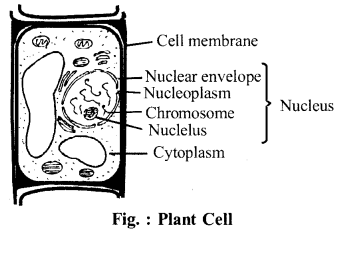
Question 2.
What are the differences between animal cell and plant cell?
Answer:
Differences between animal cell and plant cell :
| Animal Cell | Plant Cell |
| 1. It has no cell wall. | 1. It has cell wall. |
| 2. Plastids are not present. | 2. Plastids are present. |
| 3. The nucleus is in centre. | 3. The nucleus is on one side. |
| 4. The size of vacuole is small. | 4. The size of vacuole is big. |
| 5. Lysosomes are present in animal cell. | 5. Lysosomes are not found in plant cells. |
Question 3.
Draw a labelled diagram of the animal cell?
Answer:
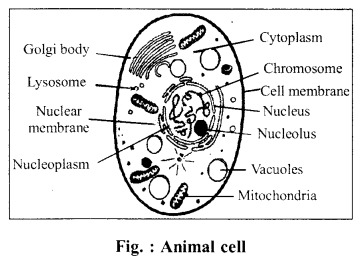
Project Work
Question 1.
Make a chart of cell structure.
Note : Students should do item their own.
Question 2.
Collect more information about cell from the website www.enchantedlearning.com/subjects/plants/cell/sj and prepare an article.
Note: Student should do it on their own.
Question 3.
Using gaming method, display the cell organelles and their functions in classroom. Various students will play the role of mitochondria, endoplasmic reticulum, plastid, vacuole etc. and explain about these. One student will play the role of an anchor.
Answer:
Some Students of the class should name them like mitochondria, endoplasmic reticulum, plastid, vacuole, lysosome, golgi body, etc and tell about them in class; like –
- Mitochondria : I am mitochondria. I am covered by a double layer membrane. I am also known as the power house of the cell.
- Endoplasmic reticulum : I am endoplasmic reticulum. I am also covered by a double layer membrane. I am of two types-Rough endosplasmic reticulum and Smooth endosplasmic reticulum. Ribosomes are attached to my rough endoplasmic reticulum.
- Plastid : I am plastid. I am present in the cytoplasm of the plant cell. I have many coloured pigments. The greeen pigments are called chloroplast. These give green colour to the leaves.
- Lysosome : I am lysosome. I contain very strong digestive enzymes. When the cells get injured or is dead, than I rupture. I am also called suicidal bag.
Question 4.
With the help of your teacher, observe a permanent slide of amoeba under the microscope. Apart from this, collect water from pond and put a drop of pond water on an empty slide and observe the organisms present in it.
Answer:
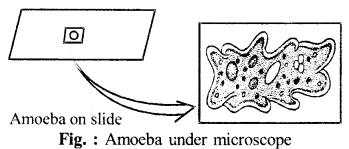
Other Important Questions
Multiple choice Questions
Question 1.
Red blood cells are
(a) Spindle shaped
(b) Square
(c) Round
(d) Branched
Answer:
(c) Round
Question 2.
The structural unit of animal is
(a) Tissue
(b) Organ
(c) Cell
(d) Organ system
Answer:
(c) Cell
Question 3.
Which of the following is not found in plant cell
(a) Plastid
(b) Mitochondria
(c) Nucleous
(d) Centrosome
Answer:
(d) Centrosome
Question 4.
Which of the following is not found in animal cell
(a) Lysosome
(b) Gogli body
(c) Plastid
(d) Nucleosome
Answer:
(c) Plastid
Question 5.
Plastid containing chlorophyll is
(a) Chromoplast
(b) Chloroplast
(c) Lucoplast
(d) Amiloplast
Answer:
(b) Chloroplast
Fill in the blanks
1. Nuclear membrane is not found in ……….. cells.
2. The largest cell is the egg of an …………. .
3. The nerve cells carry …………. from one place to another.
4. The fluid present between the cell membrane and the nucleus is called ………….. .
5. Golgi body was first described by …………. .
Answer:
1. Prokaryotic
2. Ostrich
3. Signals
4. Cytoplasm
5. Camillio Golgi
Very Short Answer Type Questions
Question 1.
What did Robert Hooke observe in a thin slice of cork?
Answer:
Robert Hooke observed honey comb – like boxes in a thin slice of cork.
Question 2.
Write the names of two unicellular organisms.
Answer:
Amoeba, Paramaecium.
Question 3.
How do we classify cells on the basis of presence of nuclear membrane?
Answer:
Two types : prokaryotic cells and eukaryotic cells.
Question 4.
Name two organisms/cells that changes shape.
Answer:
- Amoeba
- Mycoplasma.
Question 5.
What is the cell wall made up of?
Answer:
Cellulose.
Question 6.
What is nucleolus?
Answer:
Nucleus contains a small dense structure called the nucleolus.
Question 7.
What is the green pigment in plant cells called ?
Answer:
Chlorophyll.
Question 8.
What kind of vacuoles are found in plant cells and animal cells?
Answer:
Large vacuoles are found in plant cells while animal cells contain small vacuoles.
Short Answer Type Questions
Question 1.
Who discovered cell?
Answer:
Robert Hooke discovered the cells in 1665. He observed a thin slice of cork under his self made microscope. He noticed honey comb like boxes in the thin slice of cork. He coined the term cell for these boxes or compartments.
Question 2.
What is the size of cell? Explain.
Answer:
The size of cells may be as small as a millionth of a meter (micrometer) or as large as few centimeters. Most of the cells are microscopic in size. Cells are not visible to the unaided eye. They can be seen with the help of a microscope. The smallest cell is 0.1 to 0.5 micrometer, which is a bacterial cell. The largest cell is the egg of an ostrich, measuring 170 x 130 mm.
Question 3.
Draw the diagram of a muscle cell and a nerve cell.
Answer:
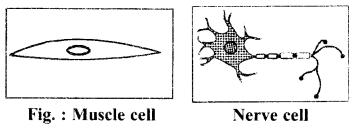
Question 4.
How is a body formed from a cell ? Explain.
Answer:
Body is formed from a cell in the following sequence :
- Cell is the structural unit of every living organism.
- A group of cells performing similar function is called a tissue.
- A group of tissues performing similar function is called an organ.
- Different organs form an organ system.
- Different organ systems form the body.
Cell → tissue → organ → system → body
Question 5.
Explain the structure of golgi body.
Answer:
Golgi body : They are flattened membraneous structures arranged one above the other. It was first described by Camillio Golgi. The substances produced in the endoplasmic reticulum are trapped in golgi apparatus and are sent to various locations inside and outside the cell.
Question 6.
Write about the structure and functions of mitochondria.
Answer:
Mitochondria : It is a structure covered by a double layer membrane. Its inner membrane is extensively folded. These folds are called cristal. Biological energy ATP is produced in the mitochondria.
Question 7.
Write about the structure and functions of endoplasmic reticulum.
Answer:
Endoplasmic reticulum appears as a network of thin tubules present in cytoplasm It is of two types :
- Rough endoplasmic reticulum
- Smooth endoplasmic reticulum.
Ribosomes are attached to the rough endoplasmic reticulum and perfom the function of protein synthesis.
Question 8.
What is a plastid? What are its types? Write their functions.
Answer:
Plastids are present in the cytoplasm of plant cells. Plastids are of three types:
- Chloroplast: They are green coloured plastids. They have chlorophyll and helps in making food with the help of the process photosynthesis.
- Chromoplast : They are coloured plastids. The different colours of flowers are due to the presence of these plastids.
- Leucoplasts : These plastids help in storing food.
Long Answer Type Questions
Question 1.
Briefly explain cell membrane and cell wall.
Answer:
Cell membrane : It is the outer covering of the cell. It is also called plasma membrane. It is porous and is made up of fats and proteins. Cell membrane allows selective substances to enter the cell and helps in removal of waste substances. This membrane is similar in animals and plants. In plants, a thick covering of cellulose is present outside the cell membrane which is called cell wall. The cell wall gives definite shape to the plant cells.
Question 2.
Explain the following :
1. Cytoplasm
2. Nucleus
Answer:
1. Cytoplasm : The fluid present between the cell membrane and the nucleus is called cytoplasm. It is a jelly like substance. Structures like mitochondria,vacuoles, golgi body, endoplasmic reticulum, chloroplast etc. are present in the cytoplasm. These structure present in the cytoplasm are called cell organelles.
2. Nucleus : It is generally spherical. In animal cell, it is located in the centre but in plant cell, it is not located in the centre and shifts towards one side due to large vacuoles. It is enveloped by a double-layered membrane. This membrane is porous and allows the movement of materials. Nucleus contains a small dense structure called the nucleolus. Nucleus contains thread like structures called chromosomes.
Question 3.
Draw a labelled diagram of a plant cell.
Answer:
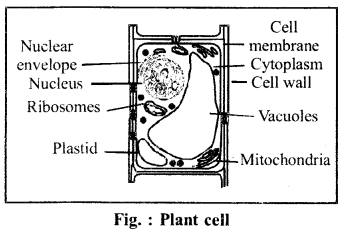
Question 4.
What do you know about Dr. Hargovind Khurana?
Answer:
Dr. Hargovind Khurana was bom in a town named Raipur of iViultan district, Punjab in the unparitionedIndia. HepassedB.Sc. (Hons.) in 1943 and M.Sc. (Hons.) in 1945 from Punjab University and went to England after receiving scholarship from the Government of India. He achieved a doctorate degree from Liverpool University by researching under the guidance of A. Robertson. Dr. Khurana was the first to show the role of nucleotides in protein synthesis. In 1968, he was awarded the Nobel prize for outstanding work in the field of genetics. Government of India awarded him the Padma Vibhusan Award.
Question 5.
Give a brief introduction of Dr. Satish C. Maheshwari.
Answer:
Satish C. Maheshwari achieved B.Sc. (Hons.), M.Sc. and Ph.D. degree from Delhi University. He researched on the embryology of duckweed (smallest flowering plant of Lemnaceae family) under the guidance of Prof. B.M. Johari. Dr. Maheshwari and group, used stamen culture technique for the advancement of crops, animal rearing and ornamental plants. 200 research papers of Dr. Maheshwari were published and he also wrote a book “Signal Transduction Mechanism in Plants”. He was awarded Bhatnagar Award, J.C. Bose gold medal, Birbal Sahni gold medal and Goyal Foundation award for his outstanding work.
We hope the RBSE Solutions for Class 6 Science Chapter 7 Cell will help you. If you have any query regarding Rajasthan Board RBSE Class 6 Science Chapter 7 Cell, drop a comment below and we will get back to you at the earliest.